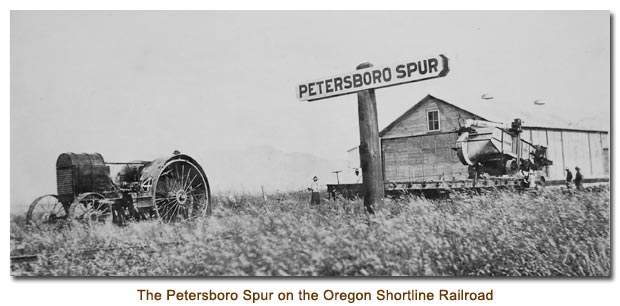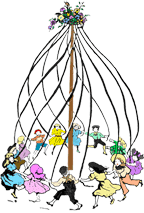Mendon and Petersboro
The area north and west of Mendon, the Petersboro area, contains the interesting seeds of an early division in the way that Mendon evolved. From the first, the bishops or presiding elder set forth the land allotments, they were established by need and ability to maintain the acres of land given. Small parcels close to town for the immediate needs of the family and larger ones further away for pasture and or grazing. No land was given to speculators of land and often land was not granted to young men whom were not yet married. Thus the resources of the town and local area were put to use by those who needed them and in an amount that corresponded to that need. It should be noted that it was intended that all should get the same amount of good land and equal amounts of marginal land, in relation to the ascertained needs of that family by the religious leader, in charge of affairs at that time.
Beauty being in the eye of the beholder notwithstanding, this allotment of land was for the most part accepted in its differing amounts and locations by the members of the ward. All of the early Cache Valley was settled under the guidance of The Church of Jesus Christ of Latter-Day Saints, as was much of the intermountain west. The town and the ward, they are and were the same, indivisible in nature and or function. When what we know today as the first true deeds to the land, were issued by the United States government, it was not uncommon for the bishop to file for the whole plat(s) in question, and then re-issue the land back to the people under the government sanction. At this time, starting in 1862, during the time of the Homestead Act(s), one could homestead a section of land, up to 640 acres with only the requirement of living on the land for a number of years and making the needed, or required improvements. This was found to be quite hard to do, so many only took a quarter section 160 or perhaps half section, equal to 320 acres for their claim. As a whole the Church or the ward did not do this. They lived as they had with the leader of the ward, the leader of the town making the decisions regarding land and land use. After 1862, you no longer needed to recieve your land from your bishop, if you did not want too. The goverment provided a deed that was more or less iron clad, as the church system moved into the goverment one, some people got slighted.
The LDS church requires one tenth of your increase for full fellowship within the ward. At the time this could be paid in kind, meaning in eggs, sheep, cattle or wheat, as well as cash. Money was in such short supply that most business was done via the barter system, this included tithing as well. I do not know the details as they have been a closely guarded. private affair for some many years… but it would seem that a few words from a church leader, perhaps in haste, perhaps not meant as taken, changed Mendon and Petersboro history forever. For the story goes that the quantity and or quality of a load of grain, wheat perhaps, was challenged upon delivery to the tithing building. This comment or remark, meant in what fashion we know not, seems to have been taken as an affront and from this exchange, Mendon creates the Petersboro area. A citizen of the United States was able under his own accord to file for land, for sections or quarter section as one choose to do. Land was filed upon in the Petersboro area without using the local ward leader and thus Mendon was cut off to the north, the only direction she could expand, by homesteaders residing in and or living among the people of Mendon.
This change was dramatic. There was no legal recourse for the ward or town, and this more or less changed the way land was handled, forever. Everyone hustled to acquire title to the lands they thought they owned, but may still be in the name of the bishop. The time of the Church dividing the land and the use of the land was over. It was then as it is now, every man for himself, capitalism at its finest. I mention this here, because the people of Mendon and the people of Petersboro are, for the most part, the same. They came from the same places, were friends with the same people. Everything is or was the same, except for the size of the family farm(s). Many in Petersboro left the church at this time, a ward or branch of the LDS church was established there for a time, but then those who lived in Petersboro would have to travel to Mendon for church affairs when this was closed. It is only now that the words once spoken and or interpreted in a hurtful way have dissipated.
A quick look at the Mendon, Utah Cemetery Index will reveal a near complete absence of many family names of Petersboro. You will find them interred over in Honeyville, at the Logan City cemetery and in Petersboro’s small private cemetery. A division if you will, a unseen boundary was placed around and or between the two entities. But everyone knew it was there. I leave not the details, for they are not important I feel, but if one were to look at the Mendon area closely, this difference would show up like a sore thumb, and many supposed causes would be manufactured to explain it. The truth or as near as I have come, is perhaps the best explanation. Not everyone moved out of town, some stayed in the city lots given by the bishop, but traveled to their new, larger farms to the north, out to Petersboro.
It is from this period that we get the Presbyterian Church forming schools in Mendon, offering church services to the members of Mendon whom no longer attend the LDS services, hoping to gain members from among those whom might teeter on their faith as well. The schools were far superior to that which the local school board could muster, quite a contention was caused when some of the LDS faithful started to send their children to these better schools. As a parent what might we do? The problems are clear and resolving them was a major issue in the town. The old log church was used as the town school, until the town was forced to build a bigger rock building, on the old tithing ground property, and acquire teachers of quality. The financial backing of the mission to the Mormons, from back east was quite a obstacle to overcome, for the trustees of the Mendon school district. In a way that could only happen in America, these various factions did battle with one another, a smile on each face the whole while. I should note that some of the young ladies whom were sent of teaching missions, out west, were married by local Mendon boys. The Mendon cemetery even contains the mother of one of these young ladies. I straightened her headstone on one of my last trips to fix-up the cemetery.
Black and white will not work here, once the rule of the bishop was superseded by the United States Government, via the homestead acts, and the few people who left the church were no longer obliged to his, nor the churches rule, the lines of demarcation are very much blurred. At this same time, in Petersboro, the art of dry farming was being experimented with, by George L. Farrell and perfected. This changed farming forever in the Cache Valley and Utah at large, George's wife was from Mendon. The one thing that is very clear from all of this, is that without farmland for the next generations to acquire, they were forced to leave Mendon and the Cache Valley for greener pastures in southern Idaho and northwestern Utah. Mendon exported here most important crop, people, the youth if the town to build and establish many communities. Look in Sugar City, Rigby, Grace and Teton. The cemetery records from these cities and Malad City read like a who’s who of Mendon, Utah. This is where Mendon expanded to and this is why.
I am glad to see that time has brought many of the folks back into the fold, that there is not a feeling any longer of you said that and we did this . . . people are people, imperfect in their dealings with one another. It would be nice if we could learn from this and other of its type. I fear it is just part and parcel of this life.
![]()
![]()
1.Mendon and Petersboro, Rodney J. Sorensen, May 3, 2006.
